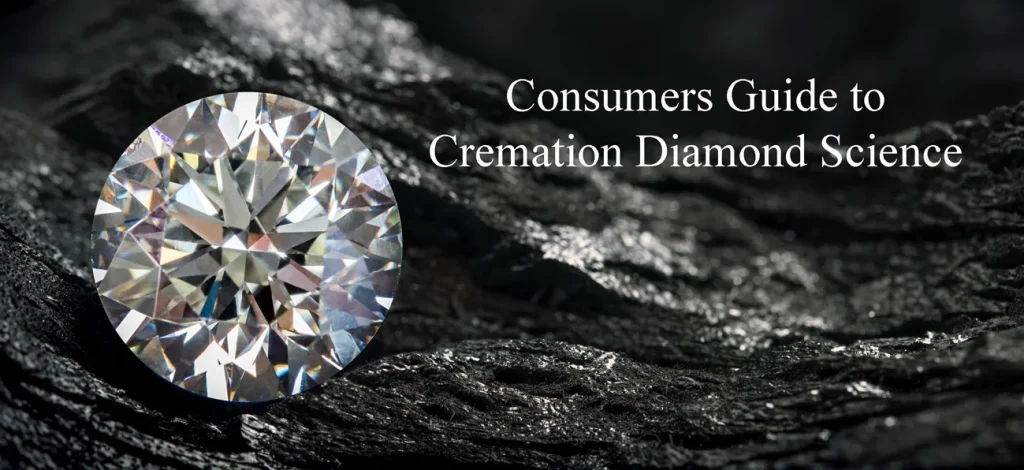 Consumers Guide to Cremation Diamond Science
Consumers Guide to Cremation Diamond Science
The claims by the cremation diamond companies do not reflect the true science of cremation “ashes” or the extraction of carbon from the results of cremation. When viewed through the proper peer-reviewed scientific research studies published in scientific journals, the claims of the cremation diamond companies fall apart. Based on our research of scientific studies, these claims turn out to be misleading to consumers. Here is a reference guide to provide you with scientific facts to help you make a more informed decision regarding your decision to purchase a cremation or memorial diamond.
1: Human bones do not contain carbon. Scientific analysis demonstrates that carbon is a trace element, not a major component of human bones. Human bones cannot supply carbon to the cremation ashes as claimed by the cremation diamond companies.
Chemical Equation for Human Bone
Here is the chemical equation of human bone. Note that carbon is not listed:
Ca₁₀(PO₄)₆(OH)₂ American Chemical Society.
Here is just one of the many scientific studies we found that prove that human bones are not made of carbon. Note that carbon is not listed as an element in human bone tissue:
DETERMINATION OF THE ELEMENTAL COMPOSITION OF HUMAN BONE TISSUE BY ATOMIC
EMISSION SPECTRAL ANALYSIS, Journal of Applied Spectroscopy, Vol. 78, No. 1, March 2011
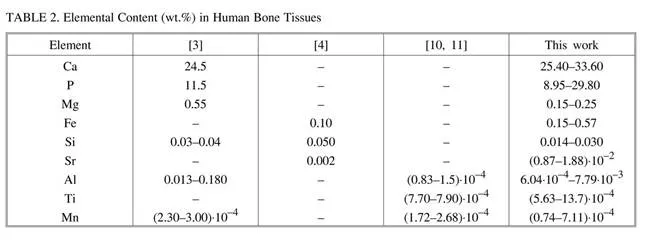
2: All (100%) of all organic carbon of the human body is lost during cremation at 600°C. Cremation ovens burn at 800°C to 1000𐩑 This is a well-documented fact based on university studies of extracting carbon from human cremation ashes for Carbon-14 dating. Please read this scientific study from Cambridge University:
“Temperature of combustion is the controlling factor in this process. All organic carbon has burned away by around 600°C, at which point bone color has shifted from gray to light bluish-gray. By 650°C the bone has become pure white. This is the calcined state.”
CALCINED BONE AS A RELIABLE MEDIUM FOR RADIOCARBON DATING: A TEST USING PAIRED NORTH AMERICAN SAMPLES, Cambridge University Press, 2017
The complete loss of all organic carbon from the cremation ashes was further confirmed in this scientific study:
“In controlled lab experiments (e.g., “Fire and Bone: An Experimental Study of Cremation” by C. Snoeck, 2013), thermal analysis via FTIR spectroscopy showed that once the bone is fully calcined (i.e., completely burned), all organic materials—including collagen—are destroyed. The only remaining carbon is inorganic, in the form of carbonate embedded in the mineral matrix.exarc.net”
Christophe Snoeck 1 R. J. Schulting 1
1 Research Laboratory for Archaeology and the History of Art, University of Oxford, Dyson Perrins Building, South Parks Rd, Oxford, OX1 3QY, United Kingdom.
3: When cremation is complete, the ashes feel grainy, not powdered, due to the bone turning into crystals of mineral apatite. All carbon is gone except trace carbon that exists within these tiny crystals. The carbon is not in the ashes.
“Infrared spectroscopy (FTIR) and X-ray diffractometry (XRD) confirm the complete loss of organics, loss of carbonates, and significant crystallographic changes in cremated bone apatite.”
EXPERIMENTAL STUDY ON THE ORIGIN OF CREMATED BONE APATITE
CARBON
C M Hüls1 • H Erlenkeuser • M-J Nadeau • P M Grootes • N Andersen
Leibniz Laboratory for Radiometric Dating and Isotope Research, Christian-Albrechts-University, Kiel, Germany. 2010
Traces of carbon are found inside the crystal lattice of the apatite crystals. This is the only carbon anywhere in cremation ashes and it is locked up in crystals, not available for creating diamonds. It must be chemically processed to extract the traces of carbon from the crystal.
4: Cremated ashes, in the form of tiny apatite crystals contain only .01% to 1.0% of trace carbon by weight. The average amount of carbon in cremation ashes is 0.30%. That is 30/100th of 1 percent. This is a trace of carbon in the ashes. The depiction below shows red as the carbon percentage. From Google Gemini AI deep search.
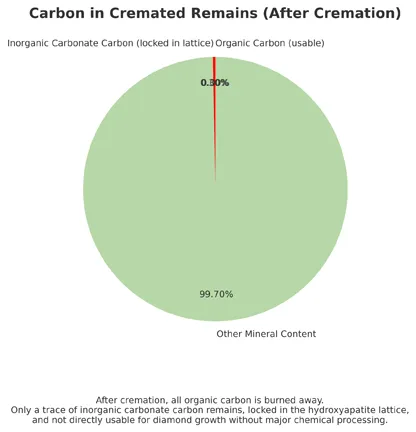
An image, generated by Google Gemini AI shows a three dimension image of the apatite crystal in cremation ashes. This is where the carbon is located in small trace amounts as shown by the red spheres. Carbon is only a minute trace element in the these tiny crystals.
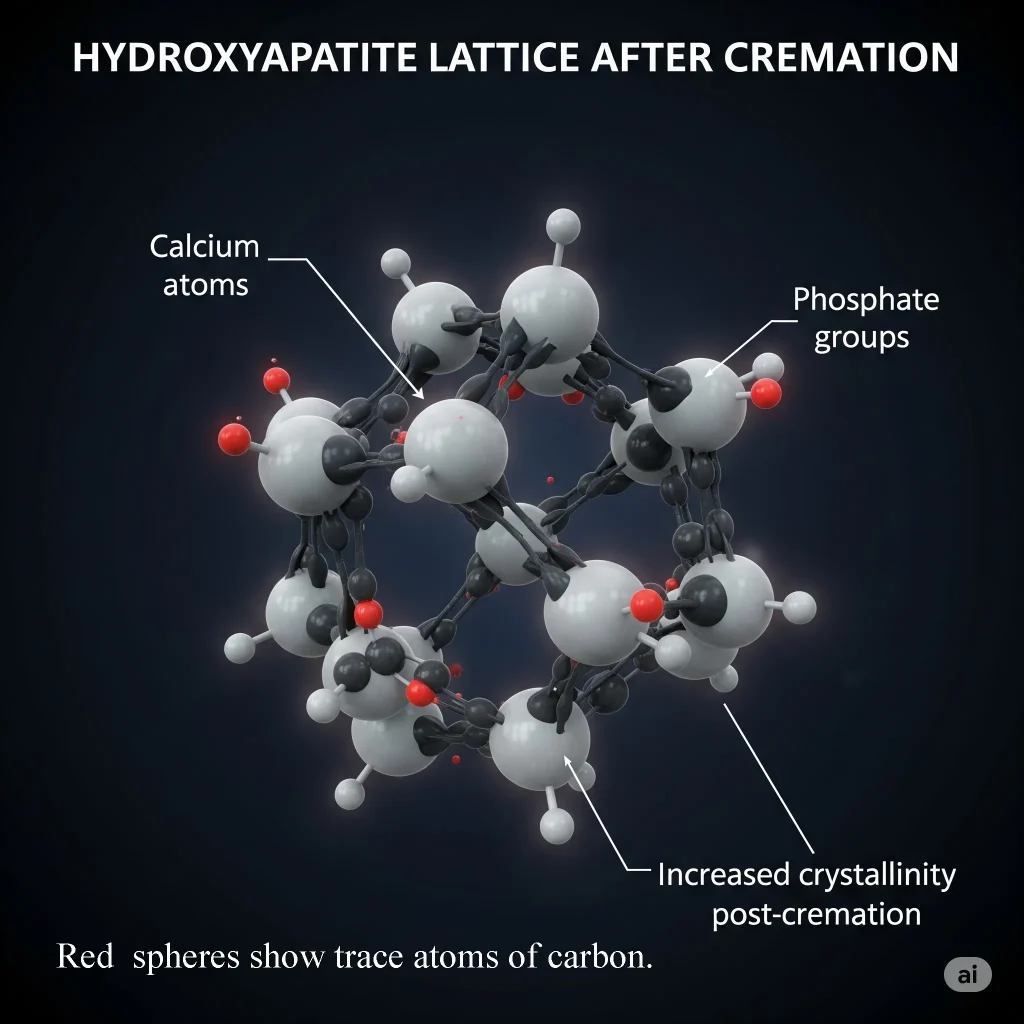
5: Since all organic carbon is burned away early in the cremation process, the question is: Where did the carbon come from in the tiny cremation crystals?

The answer: Natural gas (hydrocarbon) from the cremation oven burner adding carbon to the atmosphere inside the retort, according to the Cambridge University study on carbon in cremation ashes, which is one of many we found:
“CO2 in the atmosphere of combustion is almost entirely derived from fuel, to the extent that between 67 ± 3 and 91 ± 8 percent of the carbon in calcined bone derives from that source”
CALCINED BONE AS A RELIABLE MEDIUM FOR RADIOCARBON DATING: A TEST USING PAIRED NORTH AMERICAN SAMPLES
Published online by Cambridge University Press: 01 August 2017
6: Natural gas used in cremation ovens is methane. Methane contains 74.9% carbon. Propane is 75% carbon. From the U.S. Environmental Protection Agency and others:
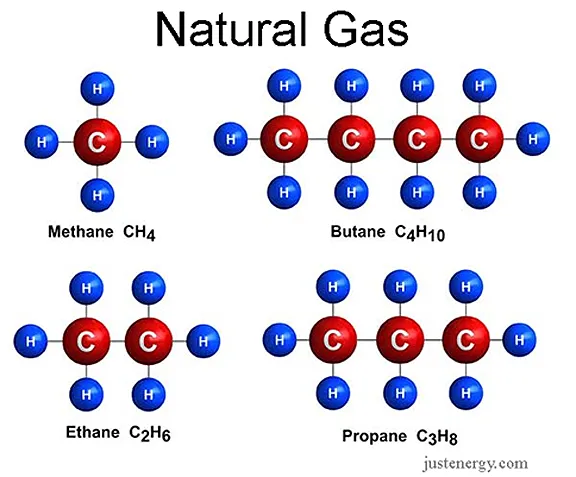
7: According to official U.S. Government scientific studies, the burners from the cremation oven put up to 2.2 kg of carbon into the atmosphere of cremation, which is absorbed into the cremation crystals formed during final stages of cremation.
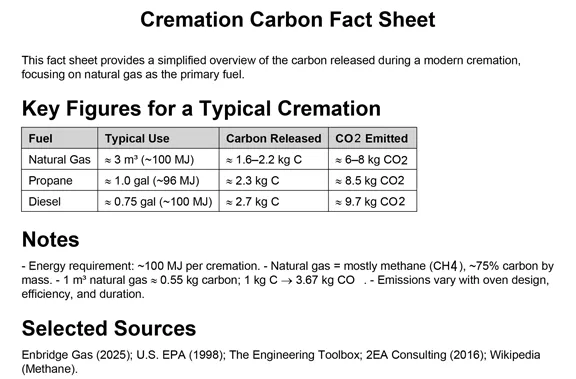
8: Cremation diamonds can be 95% carbon from natural gas oven. Based on the scientific research, lab created diamonds sold to customers as cremation diamonds have a very high, up to 99% probability of containing carbon from the cremation oven furnace that is burning natural gas……hydrocarbons…and not your loved one!
“Experimental studies have shown that during the burning process, up to 95% of the bioapatite carbon can be replaced by carbon originating from the fuel.”
The Carbon Origin of Structural Carbonatein Bone Apatite of Cremated Bones
Mark van Strydonck, MathieuBoudin, Guy De Mulder, ResearchGate, 2025
9: Cremation diamond companies like Eterneva use graphite crucibles in their labs to process ashes. Graphite is….pure carbon. Considering that all human organic carbon is lost during cremation, and the only carbon left cannot be identified from any one of the several possible non-human sources, why does Eterneva use graphite crucibles that adds its own carbon to the mix?
A photo from the Eterneva website captured August 25, 2025 is below.
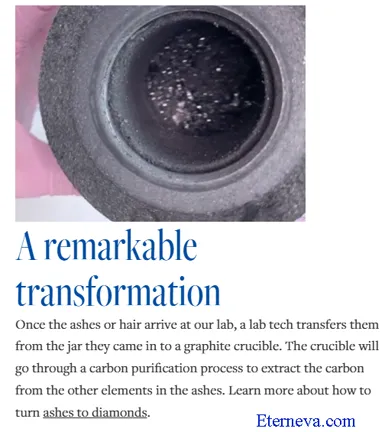
10: Eterneva’s practice makes cremation diamonds “scientifically impossible”. According to our deep research with ChatGPT AI, this practice completely negates any claims by Eterneva that they provide only carbon from your loved one in the diamond they deliver. See the ChatGPT created panel below based on AI research.
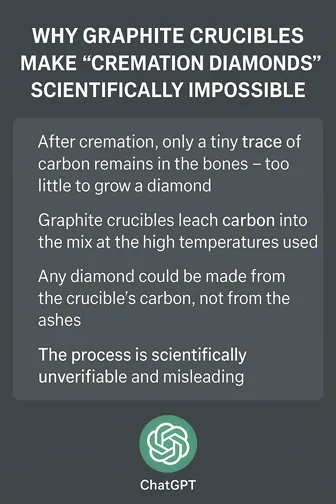
11: No independent scientific study supports Eterneva’s claims. According to Google Search AI, after an exhaustive search for scientific support of Eterneva’s claimed carbon extraction methods, no scientific study supports their claims. Please see the Google Search AI comments below:
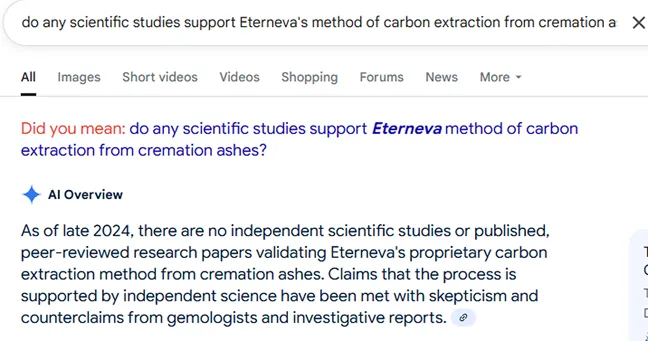
12: “Eterneva should not be used as a source for scientific information:” Google Search AI. Further searches for factual scientific studies on the science of cremation diamonds called into question the use of any claimed “science” from Eterneva (or any cremation diamond company). The actual Google Search AI response is below.
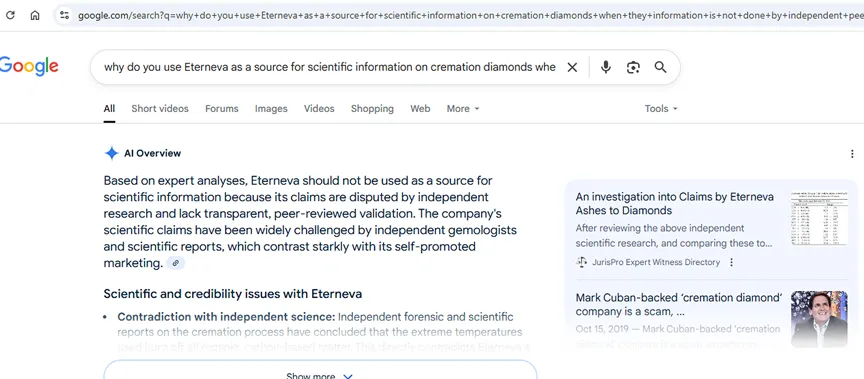
13: No organic carbon is left after cremation. Science confirms that there is no organic carbon from your loved one after cremation. And there is up to a 95% chance the carbon in your memorial diamond is from the natural gas burners of the cremation oven. Plus, the cremation diamond companies use carbon crucibles to handle your loved ones’ ashes. What is left?
14: The high financial cost of cremation diamonds. A simple market comparison demonstrates this:
Average 1.00 carat lab created diamond on the market: $700.00
Average 1.00 carat cremation diamond on the market: $15,000.00.
So, you are paying more than 21 times higher for a claimed cremation diamond than the same diamond from the open market of lab created diamonds. And the cremation diamond companies cannot provide scientific evidence that your loved one’s carbon is even in the diamond.
Final Answer: Cremation Diamonds are real diamonds, but there is no proof that they contain any carbon from a loved one’s organic carbon. In fact, just the opposite is true.
Based on peer reviewed scientific research, Cremation Diamonds have a high probability of containing carbon from natural gas and/or the graphite crucible.
Please make an informed decision based on scientific evidence and not on emotion in this very difficult time.
This research and consumer protection outreach is provides as a courtesy of Global Claims Associates because we care about you and your family.
Download this Guide on a PDF by clicking here: Consumers Guide to Cremation Diamond Science
Global Claims Associates
14436 Old Bandera Road #2
Helotes TX 78023
info@globalclaimsassociates.com
https://globalclaimsassociates.com
©2025 Global Claims Associates. ALL RIGHTS RESERVED. We encourage sharing and caring throughout the world as long as all copyrights are left intact.